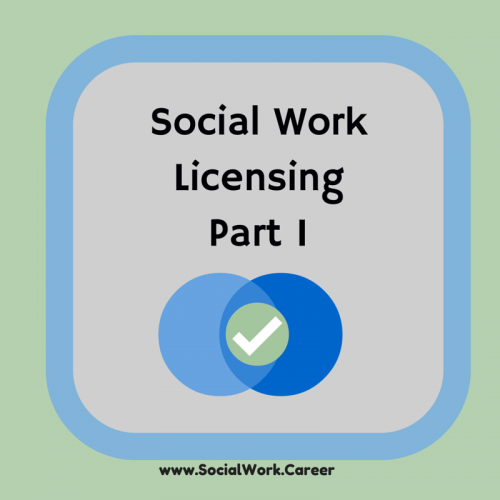
Are you aware of all the licensing requirements to become an LMSW?
In an attempt to better understand the licensing requirements for social workers, I decided to start investigating this topic before it will be covered at my school of social work this coming year.
At first glance, all the detailed instructions posted on both the State Education department site and the ASWB site can be both overwhelming and a bit of a turn-off.
My hope is to break it down into easier, more digestible bites. Therefore, I will probably be splitting the key information out over 2 (or 3 posts).
Afterwards, you can always go back to those sites to get the application forms and any additional information you’d like unless, of course, you’d prefer to jump ahead there today.
It is the New York State Education department that sets the laws, rules and regulations for the social work profession within New York state.
For other states, please visit the Association of Social Work Boards for a complete listing of states and their respective requirements.
There are the following types of licenses available to social workers:
- LMSW – Licensed Master Social Worker
- LCSW – Licensed Clinical Social Worker
- “R” psychotherapy privilege available to certain LCSWs
The major difference between being an LMSW or an LCSW is that the LMSW may only provide “clinical social work” services (i.e., diagnosis, psychotherapy and assessment-based treatment planning) under supervision; the LCSW may provide these services without supervision.
New York State LMSW License Requirements:
You must:
- Have a master’s degree in social work
- Be of good moral character
- Be at least 21 years old
- Complete 2 hr training in Child Abuse ID and Reporting
- Submit application and fee to NY State Education Department
- Pass the ASWB Masters Examination
Below is the content outline that the ASWB provides for the LMSW Masters Exam. As you can see, the content outline basically provides the framework for how the exam is organized, and includes the percentage of questions in each content area.
Examination Content Outline for LMSW Masters Examination
(Effective January 1, 2011)
I. Human Development, Diversity, and Behavior in the Environment, 28%
Theories and models
Concepts of abuse and neglect
Diversity, social/economic justice and oppression
II. Assessment and Intervention Planning, 24%
Biopsychosocial history and collateral data
Use of assessment methods and techniques
Intervention planning
III. Direct and Indirect Practice, 21%
Direct/micro
Indirect/macro
IV. Professional Relationships, Values and Ethics, 27%
Professional values and ethical issues
Confidentiality
Social worker roles and relationships
The exam is a 4 hour multiple-choice examination. While the exam has a total of 170 questions, only 150 count towards your score. The remaining twenty are pretest questions (questions which are being evaluated for possible inclusion in subsequent tests).
I’m hoping that you found this information helpful. In the next post on this topic, I was thinking of providing some additional information regarding the LMSW examination and then I would move on to the LCSW subject.
If you have already taken the LMSW exam and have some guidelines or tips to share, please do so below. Also, if you have any questions or other insights on the topic… I’d love to hear from you 🙂
Sources:
ASWB Examination Content Outline
New York State LMSW License Requirements
New York State LCSW License Requirements


Dorlee, this was really helpful!!! Thanks for sending us this post and doing all this research 🙂
-Leanne
Dorlee,
This is incredibly helpful, thank you! So appreciate your generosity in sharing.
Looking forward to the next installment. And inspired to look into this as well.
Thanks again! Ellen
Very comprehensive! The only thing that I would add is the the R really isn’t considered a license, but just a designation that qualifies you to accept certain insurance reimbursements (and provide a certain level of supervision). It preceded the licensing regulations and many people thought it would disappear when licensure was instituted. However, it persists, making the whole picture that much more confusing–typical NY State way of doing business I’m afraid 🙁
I would only add an interesting side note: that this two-tier type of licensing is controversial in social work circles–many feel that it is dividing the profession into two professions.
Leanne and Ellen,
I’m so glad that you found this post helpful.
It was my pleasure. Thanks so much for your encouraging feedback.
Best,
Dorlee
Thanks so much, Nancy, for your positive feedback and for the additional information you shared regarding the “R” designation.
While my plan was going to share some of this in Part II, I was not aware of the history at all. It is very interesting to hear that the R predated the licensing…and that it is rather controversial within the social work circles.
Warmly,
Dorlee
Dorlee,
Oh the things you can do! This is most helpful information and I look forward to reading more as the time approaches when we will be shoved from the nest of 1 washington place 🙂
Thanks again. Way to social work for social workers!
Jules
Jules,
I’m so glad that you found this information helpful.
Thanks so much for visiting. Also thanks for your social worker cheer !
Take care,
Dorlee